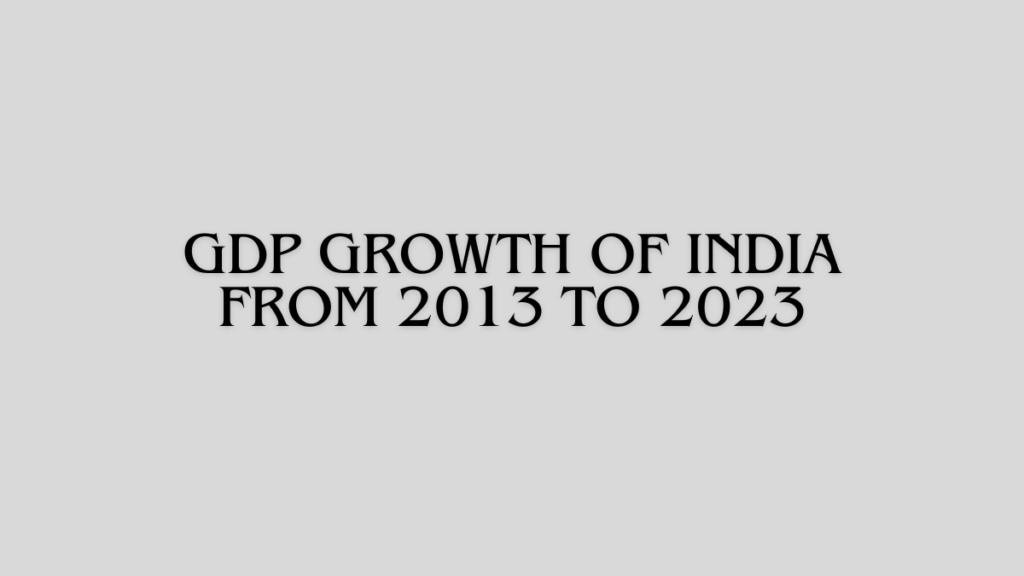
GDP Growth of India from 2013 to 2023
GDP Growth of India from 2013 to 2023: The last decade has been a transformative period for India, marked by significant economic changes and fluctuations. From 2013 to 2023, the country witnessed a rollercoaster ride in its Gross Domestic Product (GDP) growth, reflecting a dynamic interplay of domestic and global factors. In this article, we delve into the key events and trends that shaped India’s economic landscape over these ten years.
GDP Growth of India from 2013 to 2023:

2013-2014: The Early Strides
As we kick off our journey through the years, 2013-2014 stands out as a period of stable growth. India’s GDP growth was around 6.4%, with a promising start to the Narendra Modi government’s first term. Initiatives like “Make in India” were introduced to boost manufacturing, setting the stage for future economic expansion.
2016-2017: Demonetization Disruption
The year 2016 witnessed a watershed moment with the demonetization of high-denomination currency notes. While this move aimed to curb black money and corruption, it disrupted the economy, leading to a temporary slowdown. The GDP growth dipped to around 7.1%, leaving experts and citizens alike grappling with the short-term consequences.
2017-2018: GST Implementation
In the subsequent years, the implementation of the Goods and Services Tax (GST) further influenced India’s economic trajectory. Though intended to streamline taxation and enhance efficiency, the initial teething issues impacted businesses. The GDP growth for 2017-2018 hovered around 7.2%, showcasing a gradual recovery from the disruption caused by demonetization.
2019-2020: Economic Slowdown
As we approach the end of the decade, the Indian economy faced headwinds in 2019-2020. Global economic uncertainties, coupled with domestic challenges, led to a slowdown. The GDP growth dropped to approximately 4.2%, prompting policymakers to revisit strategies for sustainable development.
2020-2021: Pandemic Pummels Growth
The COVID-19 pandemic cast a long shadow over the global economy, and India was no exception. The nationwide lockdown in 2020 resulted in a contraction, with the GDP plummeting by around 7.3%. The government responded with stimulus packages and policy measures to revive economic activity, emphasizing the need for resilience and adaptability.
2021-2023: Towards Recovery
As the world grappled with the aftermath of the pandemic, India embarked on a path of recovery. The GDP growth for 2021-2023 witnessed a rebound, fueled by vaccination drives, economic reforms, and increased consumer confidence. By mid-2023, the GDP growth rate climbed back to pre-pandemic levels, showcasing the nation’s resilience and determination.
Conclusion: GDP Growth of India from 2013 to 2023
The years from 2013 to 2023 have been a tapestry of economic highs and lows for India. From policy initiatives to global shocks, each event has left an indelible mark on the nation’s GDP growth. As we look ahead, the key lies in navigating the challenges, leveraging opportunities, and building a robust economic foundation that can withstand the uncertainties of the future. The story of India’s GDP growth over the past decade is not just a numerical journey; it’s a narrative of adaptability, resilience, and the pursuit of sustainable development.

TAGS: GDP Growth of India from 2013 to 2023, GDP Growth of India from 2013 to 2023, GDP Growth of India from 2013 to 2023, GDP Growth of India from 2013 to 2023, GDP Growth of India from 2013 to 2023, GDP Growth of India from 2013 to 2023, GDP Growth of India from 2013 to 2023, GDP Growth of India from 2013 to 2023, GDP Growth of India from 2013 to 2023, GDP Growth of India from 2013 to 2023





